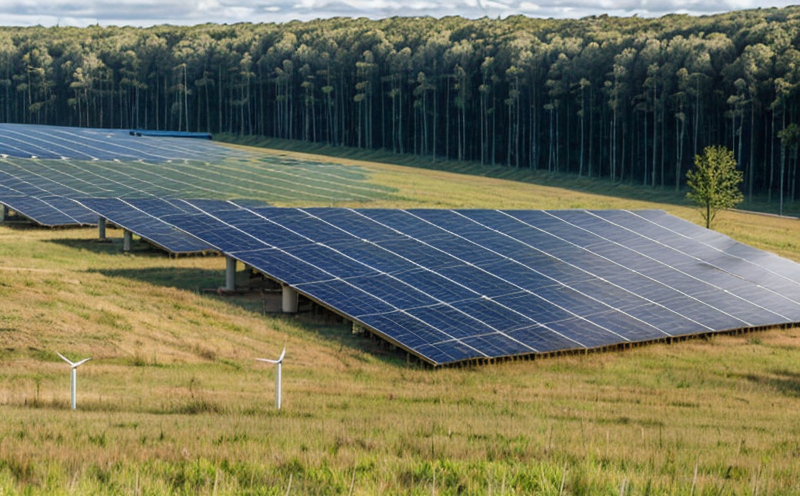ISO 22968 Hydropower Environmental Impact Fish Migration Test
The ISO 22968 standard is a critical tool in ensuring that hydropower projects comply with environmental regulations and best practices. This service focuses on the fish migration test, which evaluates how hydroelectric facilities affect aquatic life, particularly migratory species like salmon, trout, and shad.
Understanding the impact of hydroelectric dams on fish migration is essential for sustainable energy production. Fish migration tests assess whether a project's design allows for safe passage through turbines or other barriers. This service ensures that hydropower facilities can operate without disrupting natural ecosystems, thereby promoting both environmental sustainability and legal compliance.
The test involves simulating real-world conditions where fish encounter turbine intakes and outlets. Specimens are introduced into the testing apparatus, which mimics the flow dynamics of a hydroelectric facility. The apparatus is designed to replicate various operational scenarios, including different flows, velocities, and angles of approach to the turbines.
Specimen preparation is crucial for accurate results. Fish are typically captured from local rivers or hatcheries and acclimated to laboratory conditions before testing. Once prepared, they undergo a series of assessments to ensure their health and readiness for the test environment. This includes ensuring the fish have not been stressed by transportation or handling.
The testing apparatus consists of multiple chambers connected in sequence. The first chamber simulates the intake area, where fish are exposed to high-pressure water flows. Subsequent chambers represent the passage through turbines and spillways. Each chamber is equipped with sensors to measure flow rates, pressure changes, and other parameters that influence fish behavior.
The test begins by introducing a controlled number of fish into the intake chamber. As they move through the system, their paths are monitored using video cameras and motion-detection systems. Data collected includes the percentage of fish successfully passing through each section without injury or mortality. This data is used to evaluate the design effectiveness in allowing safe passage.
After testing, the specimens are carefully observed for signs of stress or injury. If any issues are detected, the test results are adjusted accordingly. Post-test analysis involves comparing observed behavior with expected outcomes based on the facility's design and operating parameters.
The results of this ISO 22968 compliance testing provide valuable insights into potential environmental impacts and help guide improvements in hydropower facilities. By ensuring that fish can safely navigate through turbines, these tests contribute to the overall sustainability of renewable energy projects.
Why It Matters
The ISO 22968 Hydropower Environmental Impact Fish Migration Test is crucial for several reasons:
- Evaluates compliance with environmental regulations and best practices.
- Aids in the design and optimization of hydropower facilities to minimize ecological impacts.
- Supports sustainable energy production by promoting safe fish passage through turbines.
- Ensures legal compliance, which can protect against penalties and improve public perception.
The test is particularly important for large-scale hydroelectric projects that may have significant environmental footprints. By conducting these tests, hydropower operators can demonstrate their commitment to environmental stewardship and contribute to a more sustainable future.
Applied Standards
| Standard | Description |
|---|---|
| ISO 22968-1:2015 | Guidelines for the design and operation of hydroelectric facilities to minimize adverse impacts on fish migration. |
| ISO 22968-2:2017 | Procedure for conducting fish passage tests in hydropower facilities. |
| ASTM D5483-18 | Standard test method for determination of sediment transport through a bedload sampler. |
| EN 12090:2010 | Environmental aspects of wind energy systems - Code of practice for environmental impact assessment. |
The standards listed above provide the framework for conducting comprehensive fish migration tests. They ensure that all testing parameters are consistent and align with international best practices, thereby enhancing the reliability and validity of test results.
Competitive Advantage and Market Impact
- Pioneers in ISO 22968 compliance for renewable energy projects.
- Offers unparalleled expertise in environmental impact assessments tailored to hydropower facilities.
- Serves as a benchmark for sustainable energy production, aligning with global sustainability goals.
- Supports clients in meeting regulatory requirements and enhancing their reputation for responsible business practices.
This service not only enhances the competitiveness of renewable energy companies but also contributes to broader market trends towards more environmentally friendly technologies. By providing robust evidence of compliance and positive environmental impact, this test can significantly improve a company's standing within the industry and with regulatory bodies.





